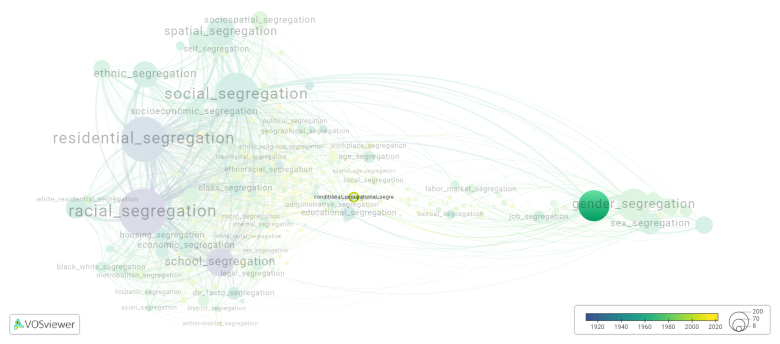Conditional occupational segregation: Difference between revisions
(Creating page) |
(Creating page) |
||
| Line 16: | Line 16: | ||
[[File:conditional_occupational_segregation.png|780x780px]] | [[File:conditional_occupational_segregation.png|780x780px]] | ||
This visualization is based on the study [[ | This visualization is based on the study [[Segregation_Wiki:About| The Multidisciplinary Landscape of Segregation Research]]. | ||
For the complete network of interrelated segregation forms, please refer to: | For the complete network of interrelated segregation forms, please refer to: | ||
Latest revision as of 07:17, 16 October 2024
Date and country of first publication[1][edit | edit source]
2013
Spain
Definition[edit | edit source]
Conditional occupational segregation refers to the phenomenon where certain groups of individuals are more likely to be concentrated in specific types of jobs or industries due to social, cultural, and economic factors. This type of segregation may occur as a result of discrimination, bias, lack of access to education and training opportunities, or other barriers that prevent individuals from entering certain fields or occupations.
For example, women may be more likely to be employed in fields such as nursing and teaching, while men are more likely to be employed in fields such as engineering and construction. This type of segregation can lead to disparities in income, career advancement opportunities, and overall job satisfaction for individuals who are disproportionately concentrated in certain occupations.
Efforts to address conditional occupational segregation may include policies and initiatives aimed at promoting diversity and inclusion in the workplace, increasing access to education and training programs for underrepresented groups, and challenging stereotypes and biases that may contribute to the segregation of certain groups in the labor market. By addressing the root causes of occupational segregation, society can work towards creating more equitable and inclusive work environments for all individuals.
See also[edit | edit source]
Related segregation forms[edit | edit source]
Conditional occupational segregation is frequently discussed in the literature with the following segregation forms:
This visualization is based on the study The Multidisciplinary Landscape of Segregation Research.
For the complete network of interrelated segregation forms, please refer to:
References[edit | edit source]
Notes[edit | edit source]
- ↑ Date and country of first publication as informed by the Scopus database (December 2023).
At its current state, this definition has been generated by a Large Language Model (LLM) so far without review by an independent researcher or a member of the curating team of segregation experts that keep the Segregation Wiki online. While we strive for accuracy, we cannot guarantee its reliability, completeness and timeliness. Please use this content with caution and verify information as needed. Also, feel free to improve on the definition as you see fit, including the use of references and other informational resources. We value your input in enhancing the quality and accuracy of the definitions of segregation forms collectively offered in the Segregation Wiki ©.
Conditional occupational segregation appears in the following literature[edit | edit source]
Gradín C. (2013). Conditional occupational segregation of minorities in the US. Journal of Economic Inequality, 11(4), 473-493. https://doi.org/10.1007/s10888-012-9229-0

